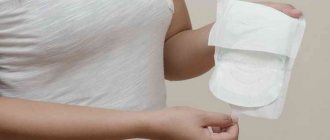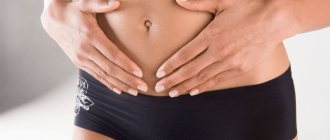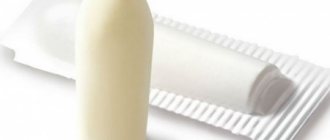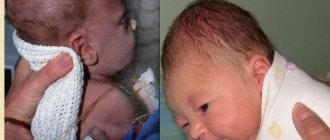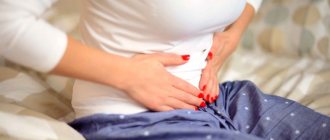During the entire period of bearing a baby, the female body changes and takes on new forms. But the most changed organ, of course, is the uterus itself, which ensures the correct development of the child in utero.
Thus, the growth of this organ from the moment of fertilization until the onset of labor may not stop, and the uterus itself (its cavity) becomes 500 times larger than its original size. Of course, such a process after the birth of the baby needs to be reversed, and therefore it is logical to assume that immediately after birth, the uterus is restored in size. But how does this happen, how much does the uterus contract after childbirth, is this process painful, like contractions?
Function of the uterus in pregnancy and childbirth
The uterus is a hollow organ consisting of several layers. The layered arrangement of tissues ensures the correct function of the organ. On the side of the abdominal cavity, the uterus is lined with a layer of mesothelium and connective tissue - perimetrium. The next (middle) layer consists of muscle tissue and is called the myometrium. It is he who is responsible for the contractile activity of the uterus. The inner mucous layer is the functional endometrium, which is responsible for implantation of the embryo.
During pregnancy, the size of the uterus increases greatly. Before conception, the reproductive organ is located in the pelvic cavity and is not visually noticeable. With each week of pregnancy, the height of the uterine fundus increases by approximately 1 cm. By the end of the gestational period, the fundus of the uterus is at the level of the stomach.
Pregnancy is a natural biological process that is controlled by hormonal levels. Progesterone, which is high during pregnancy, does not allow the uterus to contract. Shortly before labor begins, progesterone levels decrease and oxytocin production increases. Due to these changes, the muscular layer of the uterus begins to shrink, and the cervix gradually shortens and opens.
During natural childbirth, the uterus contracts, pushing out the fetus. If for some reason a woman undergoes a caesarean section, the uterus does not contract during childbirth.
Normal contraction of the uterus after childbirth
The postpartum period is the time from the birth of the child to the completion of the reverse transformation of changes. The postpartum period ends when the size of the reproductive organ reaches its pre-pregnancy size. The average duration of the postpartum period is 4-8 weeks. But sometimes for some reason this period increases.
Normal contraction of the uterus after childbirth occurs as follows:
- Immediately after expulsion of the fetus, the cavity of the reproductive organ rejects the placenta. Normally, the baby's place comes out without problems, thanks to the woman's straining. During a caesarean section, the placenta is manually separated by the doctor.
- A few minutes after the baby is born, the oval uterus takes on a rounded shape. There are still gaping capillaries in the walls of the reproductive organ, but they are gradually shrinking. The walls of the organ become thicker and denser.
- In the first 2 weeks, the uterus actively contracts. This process is accompanied by postpartum discharge - lochia. Many women mistake them for menstruation, but in their origin, menstrual blood is not at all similar to menstruation.
- 3 weeks after birth, the process of epithelization of the walls of the uterus is completely completed. The volume of discharge decreases, it becomes lighter, and by 4-6 weeks it ends completely.
The cervix returns to its original shape a week after birth. However, the cervix of a woman who has given birth and a woman who has not given birth are very different in the shape of the pharynx, length and diameter.
A woman’s pelvic organs after a natural birth require time to recover. In the first weeks, the vaginal walls are greatly stretched. Elasticity and firmness will be restored a month after birth. The size of the uterus will reach pre-pregnancy size no earlier than after 4 weeks. Therefore, in the postpartum period, a woman must strictly follow the doctor’s recommendations, abstain from sexual intercourse and the use of tampons, and also carefully monitor intimate hygiene.
How does the weight of the uterus normally change in the postpartum period:
- in a week – 500 gr.;
- after 2 weeks – 350 gr.;
- after 3 weeks – 250 gr.;
- after 1.5 months – 50 gr.
Features of uterine contraction in multiparous women
Women who give birth for the second, third, or more times have better postpartum discharge. This is due to the body's adaptation to biological changes. In addition, multiparous women already know what methods help strengthen the contractile activity of the reproductive organ.
In a multiparous woman, the height of the uterine fundus decreases by 1.5 - 2 cm daily. The total recovery period takes about 6-8 weeks.
Last method
In rare cases, if after all the methods it has not decreased, the problem is solved by cleaning the cavity. There are many reasons for your body to behave this way. Sometimes this happens when:
- a large number of lochia have accumulated;
- pieces of placenta and blood clots remained.
This causes inflammation that spreads to all organs of the female system. It happens that cleaning does not bring positive results, then surgery is prescribed to remove the reproductive organ, otherwise the consequences of bleeding will be sad.
Surgical intervention is rarely resorted to. Women who do not have serious pathologies and follow doctors' recommendations feel well after the birth of their baby and do not have any health problems.
Causes of poor uterine contraction after childbirth
Doctors monitor the contraction of the uterus after childbirth for 4-5 days. If the uterus shrinks correctly, the woman is discharged. After a caesarean section, a woman is under doctor’s supervision for more time, so discharge is planned for 6-10 days.
After giving birth, the patient remains in the maternity ward for at least 2 hours. According to indications, this period is increased. Doctors observe how the uterus contracts. If there are problems, then medications and exercises are prescribed. All women are given recommendations to improve uterine contractility. It is easier for multiparous women to recover because they are already familiar with the process and know what to expect.
Poor uterine contractions after childbirth can be caused by:
- inflammation of the walls of the reproductive organ;
- violation of the integrity of the walls of the uterus;
- the birth of a large child or multiple pregnancy;
- multiple births (usually women experience poor uterine contractions after 4-5 births);
- anatomical features of the pelvic organs;
- bending of the uterus;
- the presence of neoplasms;
- blood clotting disorder;
- pregnancy pathologies (for example, polyhydramnios);
- hormonal imbalance;
- refusal of breastfeeding;
- neglect of medical recommendations.
Folk remedies
More and more obstetricians are turning to the recommendations of alternative medicine, advising women in labor to drink herbal teas, infusions, and decoctions. Recipes are selected individually and are a good addition to medical practice.
Infusion of nettle or shepherd's purse:
- take 2 tbsp. dried herbs and pour a glass of boiling water;
- leave until completely cooled;
- filter.
It is better to mix the composition in a thermos, so the drink turns out to be more saturated with useful substances. The infusion is prepared in the evening, and the next day a glass of the drink is divided into 3 doses, regardless of meals.
Infusion of homemade geranium. This strong-smelling flower is found on windowsills. One of the healing properties of geranium is its ability to influence the contractile processes of the uterus. The drink is prepared from 2 tsp. pre-dried crushed leaves, filled with 2 glasses of boiled chilled water. Infuse for at least 12 hours and distribute the liquid throughout the day, drinking in equal portions.
Claryberry decoction. The drink is prepared either from the leaves alone (dry) or in combination with the flowers of the plant. Grass in the amount of 2 tbsp. pour cold water (0.5 l), put on fire, and after boiling, simmer in a water bath for 30-40 minutes. Next, infuse, filter and distribute into 4 servings, which should be drunk during the day.
Viburnum juice. The fruits of the tree are indispensable for various female problems. Wedge juice helps if the uterus contracts too slowly. If you need fresh berries, when they are prepared for future use, it is better to use vacuum freezing. The juice is taken before meals, 1 tablespoon, and the drink should be freshly squeezed each time.
Traditional recipes are a good addition to basic recommendations and methods. But they can also become basic if breastfeeding women have contraindications to traditional medicine. Using the gifts of nature, the mother’s predisposition to allergies is also taken into account.
Symptoms of poor uterine contractions after childbirth
Signs of poor uterine contractions usually appear in the delivery room. Therefore, after the placenta is rejected, the woman is monitored - blood pressure, pulse, body temperature, and discharge from the genital tract are monitored. Signs of poor uterine contractions may appear later, even after discharge from the hospital. Therefore, if disturbing symptoms appear, you should immediately seek medical help.
Symptoms:
- heavy bleeding;
- discharge of clots from the genital tract;
- absence of postpartum discharge or its completion earlier than after 3 weeks;
- abdominal pain;
- general weakness, faintness;
- unpleasant odor from the genital tract;
- increased body temperature;
- inflammation of the sutures (after cesarean section or episiotomy).
Body temperature after childbirth is measured twice a day. To change, choose the elbow bend. In the armpit, the temperature may be above 37 degrees due to lactation.
Doctor's help
How to understand that the help of an experienced physician is needed at the moment?
It happens that in the first days (1-3 days) the woman’s involution process does not start: there is no characteristic vaginal discharge, no painful sensations bother her. To establish a natural process, the doctor may prescribe medications or injections of the drug oxytocin. This manipulation will help speed up the contraction process and prevent heavy blood loss. When the mother's body is weakened, it is recommended that she be given droppers with the same drug.
If the artificial hormone oxytocin is not available, you can resort to other substances:
- ergotal;
- ergometrine;
- pituitrin;
- methylergometrine;
- methyloxytocin;
- dinoprostone;
- dinoprost;
- demoxytocin;
- hyfotocin.
These drugs also successfully cope with the assigned tasks; they can be used in the form of capsules and injections. Doctors prescribe such medications only when there are no contraindications and there is a real need (the natural renewal process does not start on its own, the necessary symptoms are absent).
What to do if the uterus contracts poorly after childbirth
If there are symptoms of poor uterine contractions after childbirth, you should immediately consult a doctor. The problem is quite serious and in the absence of medical attention can develop into a complication.
If you suspect poor uterine contractions after pregnancy, the doctor will perform an ultrasound and examine the patient in a chair. If necessary, additional tests are prescribed: blood test, urine test, determination of hormonal levels and others.
To stimulate contractile activity of the uterus after childbirth, the patient is given individual recommendations:
- daily regime;
- breastfeeding regimen;
- exercises;
- drugs.
Medicines for uterine contractions
If the uterus contracts poorly, the woman is prescribed symptomatic medications and medications to stimulate contractile activity.
Symptomatic remedies alleviate the patient’s condition, relieve pain, and relieve spasms. Doctors usually recommend drugs based on drotaverine (No-Shpa) and metamizole sodium (Analgin). It is not recommended to take acetylsalicylic acid and some NSAIDs (non-steroidal anti-inflammatory drugs) as they can cause excessive bleeding.
Drugs for uterine contractions after childbirth increase the activity of the myometrium. Such drugs can only be taken as prescribed by a doctor. Traditionally, in the treatment of poor uterine contractions after childbirth, Oxytocin injections in individual dosages are used. For outpatient treatment, a woman is prescribed sublingual tablets.
Women take Tincture of Water Pepper or Nettle Decoction on their own. However, doctors warn that self-administration of medications during breastfeeding is unacceptable. It is impossible to predict how the baby’s body will react to this or that drug. Herbs, tinctures and decoctions can be much more dangerous than traditional medicines.
How to increase uterine contractions after childbirth on your own
At home, you can increase uterine contractions after childbirth. Doctors recommend:
- Breastfeed your baby. Stimulation of the nipples during sucking increases the production of oxytocin. Multiparous women clearly feel the contraction of the uterus during feeding.
- Be more active. You should not lie down after childbirth if there is no indication for this. The more a woman moves, the better the uterus will contract. Of course, we are not talking about sports or intense physical activity.
- Sleep on your stomach. Doctors in the maternity hospital give this advice. However, many women find it difficult to sleep on their stomach due to milk flow.
- Empty your bladder in a timely manner. After childbirth, the urge to urinate is felt weakly. It is necessary to go to the toilet at least once every three hours.
- Monitor bowel function. After childbirth, many patients experience constipation. Stagnant processes in the intestines inhibit uterine contractions. To prevent constipation, a healthy diet, drinking regimen and physical activity are recommended.
- Maintain intimate hygiene of the genitals. Inflammation of the uterus impairs contractile activity. To prevent infection, it is necessary to carefully observe the rules of intimate hygiene, not to use tampons, and also to abstain from intimacy for the entire recovery period.
Exercises to contract the uterus after childbirth:
- in the “supine” position, straighten and bend the limbs;
- lying on your back, pull the toes of your feet towards you, and then relax;
- in the “standing” position, perform circular movements with the pelvis alternately in one direction and the other;
- Kegel exercises (tension and relaxation of the vaginal muscles).
Cleaning the uterus after childbirth due to poor contractions
Cleaning the uterus after childbirth is performed if other methods do not cope with the problem. The operation is performed in a medical facility and takes no more than 20 minutes. One of the indications for surgery is cervical stenosis - an unnatural narrowing that does not allow postpartum discharge to pass. Anesthesia is used for pain relief. After cleaning, the woman is under the supervision of specialists for several hours and then goes home.
After cleaning the uterus, the patient is given general recommendations that help improve the contractile activity of the myometrium.
Must know
During the period described, you need to force yourself to go to the toilet, since it is extremely undesirable to endure it. In addition, a woman, as a rule, has swelling of the neck of the bladder because during childbirth it was squeezed by the baby's head. Because of this, during the first urination the sensation may not be the most pleasant. To make this process more active, you need to move as much as possible.
In a full state, the bladder will interfere with physiological contractions. If this cannot be done naturally within 8 hours, then doctors use a catheter.
Prevention
It is necessary to take care of the smoothness of the postpartum period in advance. For the uterus to contract well, it is important:
- take a responsible approach to pregnancy planning, undergo examination before conception;
- be regularly examined by a doctor about pregnancy, take all tests and perform diagnostic procedures;
- avoid infection of the uterus during pregnancy, monitor intimate hygiene;
- choose a certified medical institution for childbirth;
- promptly go to the maternity hospital at the first signs of labor;
- do not take medications on your own, including those for inducing labor;
- maintain adequacy during natural childbirth, listen to the doctor’s advice;
- do not refuse medical care after childbirth, undergo all examinations and strictly follow the recommendations of a specialist.
Much attention is paid to contraction of the uterus after childbirth. The future health of a woman depends on the speed of restoration of the size of the pelvic organs. Nature provides for independent contraction of the uterus, and breastfeeding accelerates this process.
For quick recovery
There are specially designed gymnastics after childbirth to contract the female reproductive system. With its help, processes go faster. The positive aspects of exercise are also a lift in mood and a boost of energy.
Women should take into account the following rules:
- You need to exercise regularly in a well-ventilated area;
- clothing should not restrict movement;
- do training on an empty bowel and bladder;
- be sure to adhere to the recommended pace;
- movements should be slow, without holding your breath, gradually increasing the load:
- the same type of movements can negatively affect health, so they should be varied so that all muscle groups are involved;
- You should train an hour or an hour and a half before eating and after feeding;
- be sure to drink plenty of fluids, otherwise milk production may decrease;
- You should get up from a lying position by turning to the side.
It is necessary to do restorative gymnastics 10-12 weeks after the birth of the child.
It is advisable to do it from the first day of the postpartum period. It is advisable for mom to move more.
Read also: Why does the anus hurt after childbirth?


